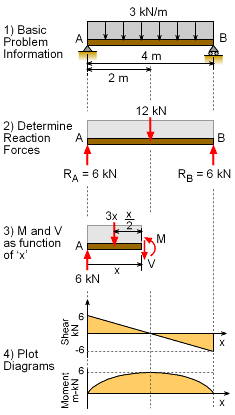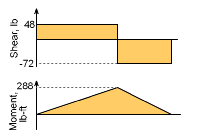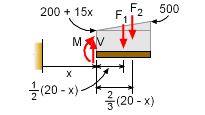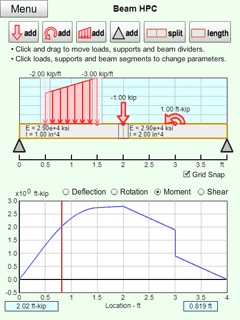| Ch 3. Beam Shear/Moment Diagrams | Multimedia Engineering Mechanics | ||||||
|
Shear and Moment |
Shear/Moment Diagrams |
Moving Loads |
|||||
| Shear/Moment Diagrams | Case Intro | Theory | Case Solution | Example |
| Chapter |
| 1. Stress/Strain |
| 2. Torsion |
| 3. Beam Shr/Moment |
| 4. Beam Stresses |
| 5. Beam Deflections |
| 6. Beam-Advanced |
| 7. Stress Analysis |
| 8. Strain Analysis |
| 9. Columns |
| Appendix |
| Basic Math |
| Units |
| Basic Mechanics Eqs |
| Sections |
| Material Properties |
| Structural Shapes |
| Beam Equations |
| eBooks |
| Dynamics |
| Fluids |
| Math |
| Mechanics |
| Statics |
| Thermodynamics |
| ©Kurt Gramoll |
|
|
||
| Introduction |
||
| It is important to know how the shear forces and bending moments vary along the length of a beam that is being designed. Graphs are used to describe the change of shear forces and moments. These graphs are called shear and moment diagrams. Employing these diagrams, the maximum and minimum shear and moment are easily identified and located. | ||
| General Method to Develop Shear and Moment Diagrams |
||
|
|
Constructing shear and moment diagrams is similar to finding the shear and moment at a particular point on a beam structure. However, instead of using an exact location, the location is a variable distance 'x'. This allows the shear and moment to be a function of the distance, x. In theory, this appears to be simple, but the equations can be complex, especially with distributed loads that are also a function of the location, x. Also, if there are multiple loads or supports, more than one function must be developed, i.e. one shear and moment function for each section or span of the beam. The general steps for shear and moment diagrams are as follows:
It should be noted that this example is fairly simple with one load type and simple supports. More complex examples are given below with multiple beam segments and loads. Also, the sign convention is important and is reviewed below. |
|
| Sign Convention |
||
|
|
When constructing shear and moment diagrams, the sign convention is important so viewers will know what direction the beam is bending or shearing. Generally, it is assumed that a positive moment causes a beam to bend downward as shown in the diagram. A positive shear will skew the beam with the left side going up and the right going down, as shown. Each textbook can have different conventions, so it is important that you check what directions are positive or negative. |
|
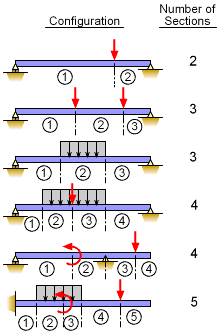 Multiple Beam Sections for Different Loading Configurations |
Notice, all internal moments and shears need to cancel out if the cut section is reassembled. This means the direction is opposite on the right and left faces of the cut. | |
| Multiple Beam Sections (or Segments) |
||
|
One confusing aspect of developing moment and shear diagrams is the need to have separate moment and shear functions for each beam segment. This is because a single function cannot model the moment (or shear) change over a load or support (it is a discontinuous function). Each new beam section will have its own moment and shear equations as a function of the location, x. The diagram at the left gives various beams and typical loadings. After each section is cut, then a FBD is drawn for either side of the beam, just like a single section beam discussed above. Then the M and V is determined for that cut and plotted. |
||
| Example: Multiple Beam Sections |
||

|
Moment and shear diagrams are best understood by examining an example. The simple support beam at the left has a single point load between the supports. The first step is to draw a FBD of the whole beam and solve for the reactions. |
|
 |
ΣMA = 0 ΣFy =
0 |
|
 |
Determine Beam Section |
|
|
|
Section (1) (0 ≤ x ≤ 6 ft) The left beam section must stay in static equilibrium. ΣFy = 0 ΣMcut =
0 |
|
|
|
Section (2) (6≤ x ≤ 10 ft) Again, applying the static equilibrium equations gives, ΣFy = 0 ΣMcut =
0 Plot Shear and Moment Diagrams The location for maximum and minimum shear force and bending moment are easily found and evaluated. |
|
| Complex Distributed Load Example |
||
|
Distributed loading is one of the most complex loading when constructing shear and moment diagrams. This causes higher order polynomial equations for the shear and moment equations. Recall, distributed loads can be converted to equivalent forces which are easier to work with. Also, complex, non-uniform distributed loads can be split into simpler distributed loads and treated separately. |
||
 |
An example is the best way to illustrate how to work with non-uniform distributed loads. Take a simple cantilever beam with a linear varying distributed load as shown at the left. This example has only one beam segment, so only one cut will be needed. | |
 |
Cut the beam some distance x from the left. If the right part of the cut beam is used, then the support reactions at A do not need to be determined (this is a unique situation). The distributed load intensity, wcut, is a simple linear relationship between A and B, or wcut = 200 + (x/20)(500-200) |
|
|
|
The distributed load can be split into two parts, a rectangular and triangular shape. The equivalent loads, F1 and F2 of each shape are calculated as F1 = (20 - x) (200 + 15x) F2 = 0.5 (20 - x) [500- (200 + 15x)] The internal moment and shear, M and V, can now be determined using the equilibrium equations, ΣFy = 0 |
|
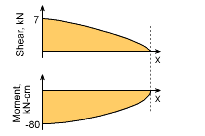 |
ΣMcut =
0 Both the shear and moment can now be plotted as a function of position, x, to give the moment/shear diagrams. Since the distributed load was changing linearly, the shear is a quadratic equation and the moment is a cubic. |
|
| Moment and Shear Relationship |
||
From the examples given in this section, it is possible to see an interesting relationship between the shear and the moment. The shear at a given location is the slope of the moment function. In mathematical terms, this is written as, V = dM/dx This relationship may be helpful in determining both the moment and shear diagram without calculating the actual function. Derivation of this relationship is done in the Integration of Load Equation. |
||
| Moment-Shear Diagram Calculator Tool |
||
|
For complex beams with more than a couple loads, determining moment and shear diagrams is very difficult. Thus, most structural engineers will use a beam analysis tool to calculate moments and shear. A free simple one (screenshot at left) has been developed by the author, and is availble for mobile devices. The tool can generate the moment and shear diagrams, and will also give support reactions. For Android mobile devices, "Beam HPC" calculator, can be downloaded at Google Play. For iOS (Apple) mobile devices, "Beam HPC" calculator, can be downloaded at iTunes. |
|
|
|
||
Practice Homework and Test problems now available in the 'Eng Mechanics' mobile app
Includes over 500 free problems with complete detailed solutions.
Available at the Google Play Store and Apple App Store.
